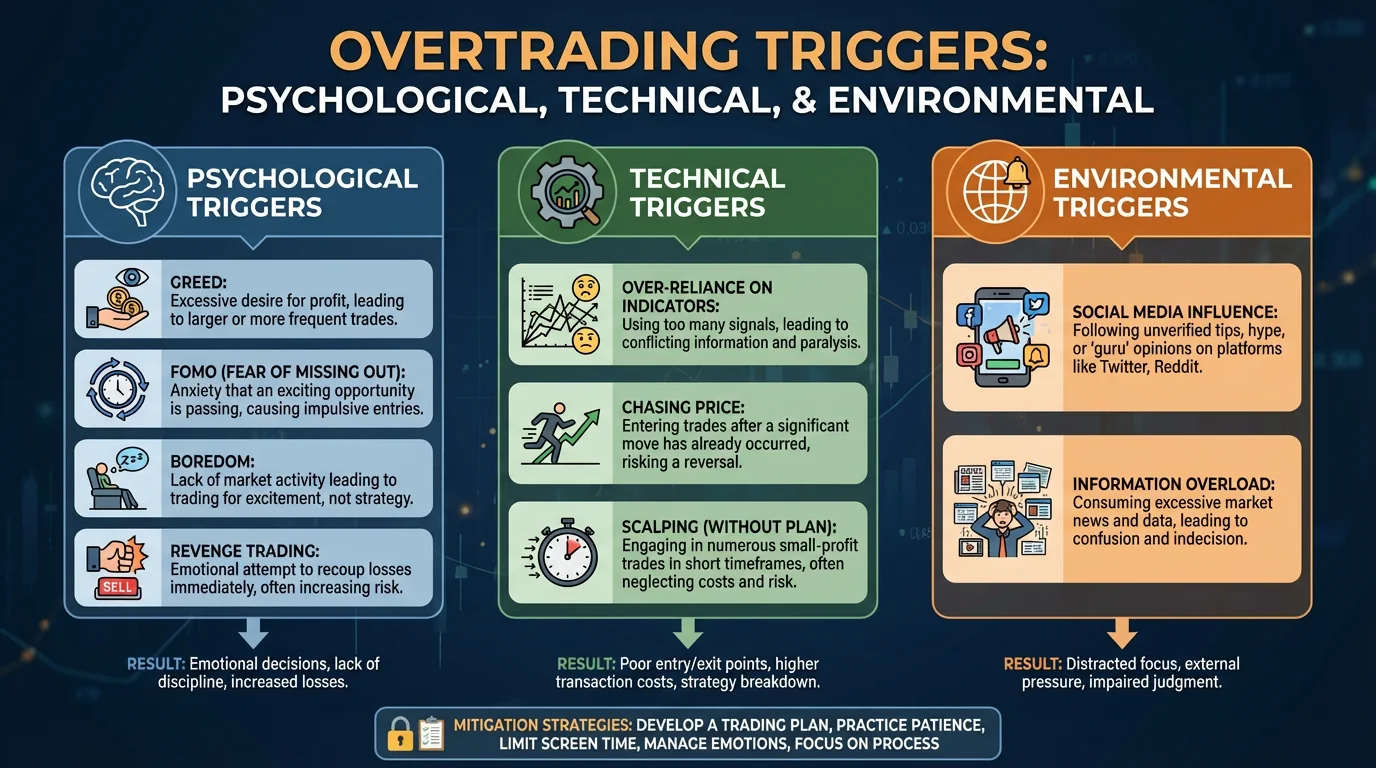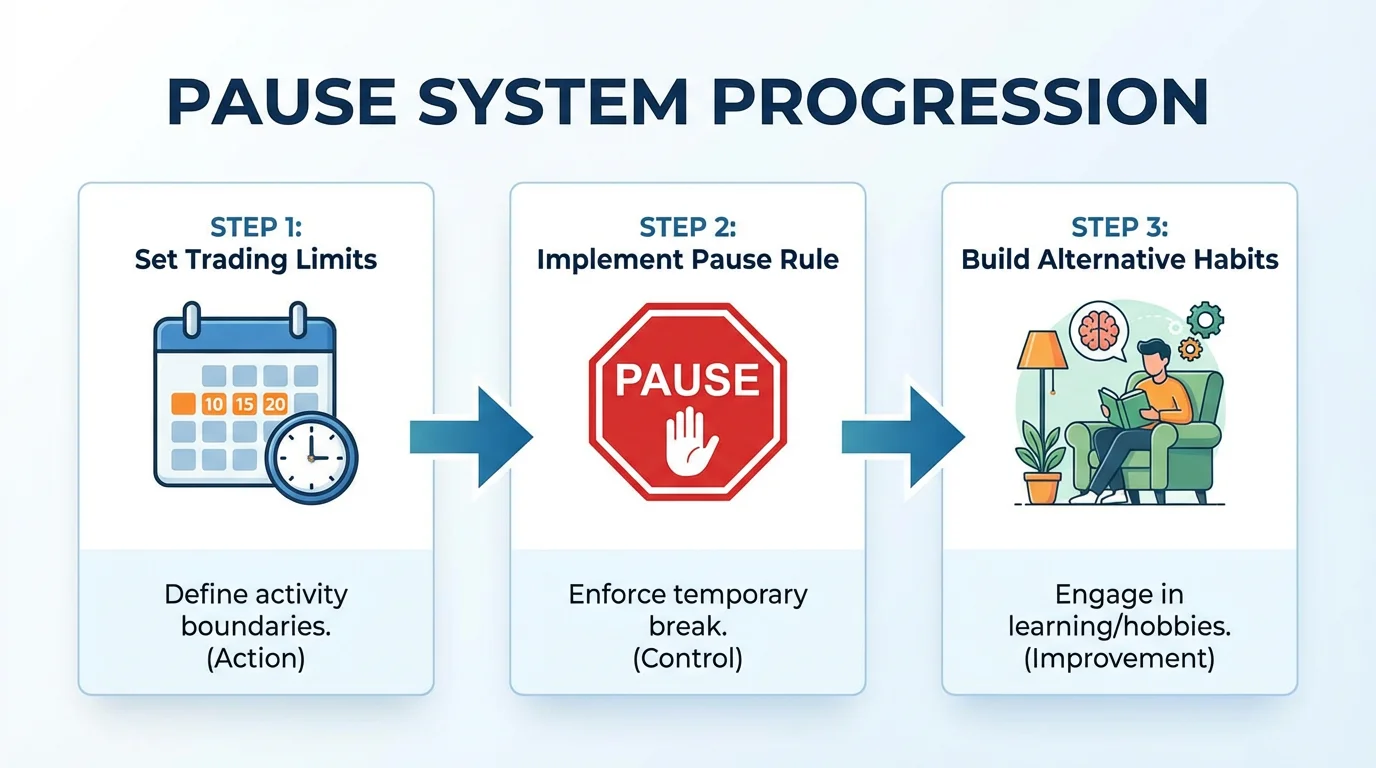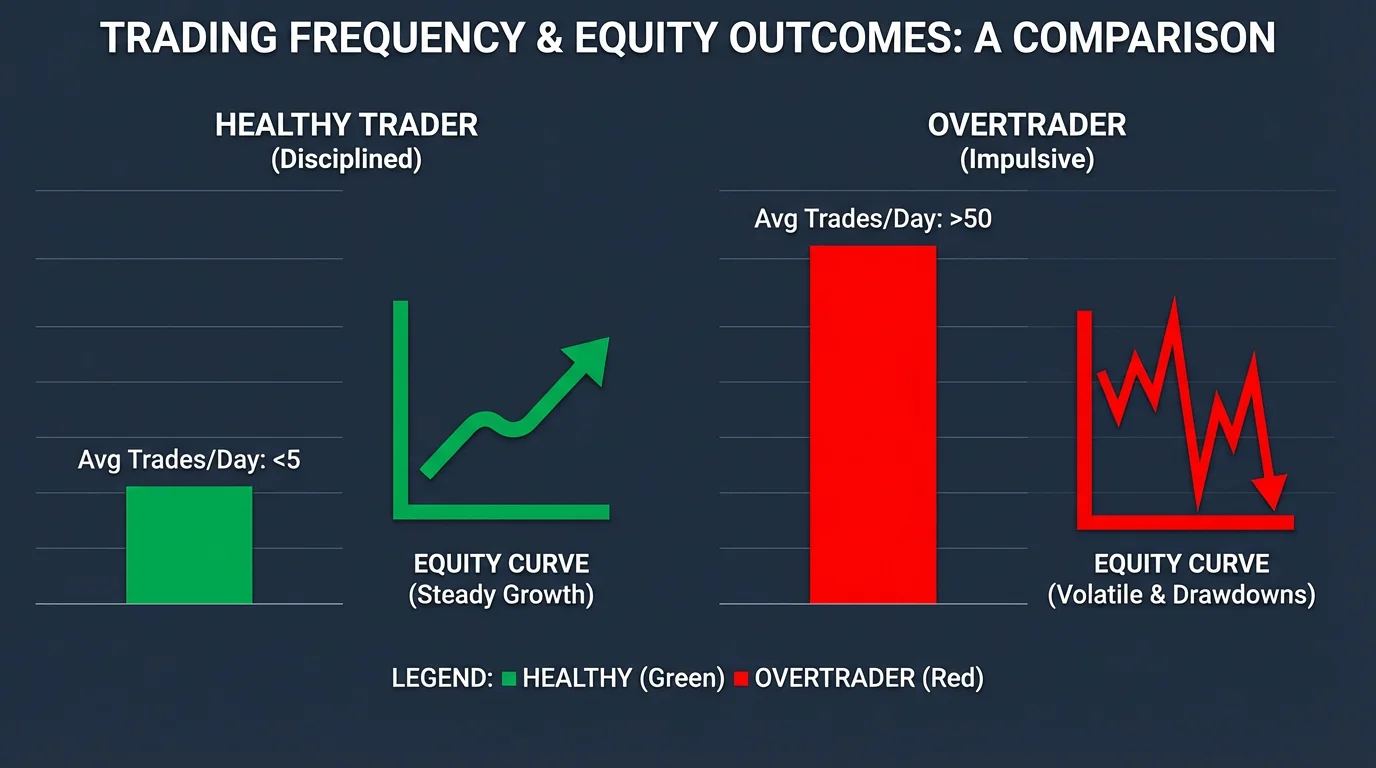In the world of Forex trading, the allure of constant action can be intoxicating. The 24/5 nature of the market, combined with the instant accessibility offered by modern trading platforms, creates an environment where it’s easy to fall into the trap of overtrading forex. Overtrading, or the excessive buying and selling of securities, is a common and often devastating problem that affects traders of all experience levels. It is a behavioral issue that is driven by a complex mix of psychological, technical, and environmental factors. This article will explore the “Overtrading Syndrome,” helping you to recognize its triggers and symptoms, and providing a practical “pause system” to help you build new habits and reverse this destructive pattern.
What is Overtrading? Defining the Problem

Overtrading is not simply about the number of trades you take; it’s about the quality of those trades and whether they align with your trading plan. A high-frequency trader might execute hundreds of trades in a single day as part of a well-defined and profitable strategy. In contrast, a swing trader might be overtrading if they take just a few trades a week that are outside of their trading plan. At its core, overtrading is any trading activity that is not aligned with your trading plan and that is driven by emotion rather than by objective analysis.
The distinction between active trading and overtrading is an important one. Active trading, when done according to a well-defined plan, can be profitable. Overtrading, on the other hand, is always destructive. It’s the difference between a surgeon making precise, calculated cuts and a person flailing around with a knife. Both involve action, but only one is productive.
Overtrading can manifest in several ways, including:
– Taking trades that do not meet your entry criteria. You see a price movement and immediately jump in, without waiting for your specific setup to occur.
– Trading with position sizes that are too large for your account. You increase your risk per trade beyond what your trading plan allows.
– Constantly jumping in and out of the market without a clear reason. You’re in and out of trades multiple times per hour, with no clear strategy.
– Feeling the need to be in a trade at all times. You feel anxious or bored when you’re not in a trade, so you force yourself into trades just to feel like you’re doing something.
– Trading during low-probability times. You trade during times when your strategy is less likely to work, such as during news events or during low-volatility periods.
The Practical Triggers of Overtrading: Understanding the Root Causes

To overcome overtrading, it’s essential to understand what triggers it. The triggers can be broadly categorized into three groups: psychological, technical, and environmental. By identifying which triggers are most relevant to you, you can develop targeted strategies to address them.
Psychological Triggers
Greed: The desire to make more money can lead you to take on more risk and to trade more frequently than you should. A trader who has had a few winning trades may become overconfident and start to believe that they can make money on every trade. This can lead them to lower their entry criteria and to take on larger positions.
Fear of Missing Out (FOMO): Seeing other traders making money or hearing about big market moves can create a sense of urgency and a fear that you are missing out on profitable opportunities. Social media has amplified this trigger significantly. Traders see posts from other traders showing their winning trades and feel compelled to jump into the market to capture similar gains.
Boredom: The Forex market can be slow at times, and this can lead to boredom. Some traders may enter trades simply to relieve their boredom and to feel the excitement of being in the market. This is particularly common during slow trading sessions, such as during the Asian session when volatility is low.
Revenge Trading: As discussed in a previous article, the desire to win back losses can lead to a cycle of reckless and impulsive trading. A trader who has suffered a loss may feel compelled to immediately enter another trade to recover the loss, without waiting for their normal setup to occur.
Need for Control: Some traders overtrade because they feel the need to control their trading results. They believe that if they trade more, they will have more opportunities to make money. In reality, trading more often without a clear plan simply increases the probability of losses.
Technical Triggers
Over-reliance on Technical Indicators: Some traders may become so focused on their technical indicators that they start to see trading signals where none exist. They may have 10 or 20 different indicators on their chart, and they interpret every crossover or divergence as a trading signal.
Chasing Price: When a currency pair is making a strong move, it can be tempting to jump in and chase the price. This is a classic overtrading mistake that often leads to buying at the top or selling at the bottom. The trader sees the price moving and feels like they’re missing out, so they jump in without waiting for a pullback or a confirmation.
Scalping without a Strategy: Scalping, or the practice of taking very small profits on a large number of trades, can be a legitimate trading strategy. However, if it is done without a clear plan, it can quickly devolve into overtrading. A trader might take 50 scalp trades in a day, each one for just a few pips, and end up losing money overall due to commissions and slippage.
Indicator Whipsaw: When the market is ranging or consolidating, technical indicators can generate false signals. A trader who is relying on these signals may enter and exit trades repeatedly, each time taking small losses due to commissions and spreads.
Environmental Triggers
Social Media: The constant stream of trading ideas and success stories on social media can create a sense of pressure to be constantly trading. Traders see posts from other traders showing their winning trades and feel compelled to be active in the market as well.
Information Overload: The sheer volume of news and analysis available to traders can be overwhelming. This can lead to a state of “paralysis by analysis,” where traders are unable to make a decision, or it can lead to overtrading, as traders try to act on every piece of information they receive.
24/5 Market Access: The fact that the Forex market is open 24 hours a day, 5 days a week, means that there is always something happening. This can create a sense of urgency and a fear of missing out. A trader might feel compelled to trade during times when they normally wouldn’t, such as late at night or early in the morning.
Trading Platform Notifications: Many trading platforms send notifications for every price movement, economic news, or analyst recommendation. These notifications can trigger impulsive trading decisions.
Recognizing the Signs of Overtrading: Self-Assessment

Recognizing that you have a problem is the first step to solving it. Here are some of the common signs of overtrading:
– Your trading performance is inconsistent. You have periods of high profitability followed by periods of significant losses. Your equity curve looks like a roller coaster, with sharp ups and downs.
– You are constantly feeling stressed and anxious about your trading. Even when you’re not actively trading, you’re thinking about the market and worrying about your positions.
– You are spending an excessive amount of time in front of your trading screen. You’re checking the market multiple times per hour, even when you don’t have any open positions.
– You are neglecting other important areas of your life, such as your work, your family, and your health. Trading has become all-consuming, and you’re sacrificing other important things for it.
– You are breaking your trading rules on a regular basis. You know what your trading plan says, but you’re not following it. You’re entering trades that don’t meet your criteria, or you’re exiting trades early.
– Your trading costs are eating into your profits. You’re paying a lot in commissions and spreads due to the high number of trades you’re taking.
– You can’t explain why you entered a trade. If someone asks you why you entered a particular trade, you struggle to give a clear, logical answer.
The “Pause System” for Habit Building and Behavioral Change
Breaking the habit of overtrading requires a conscious and deliberate effort. The “Pause System” is a simple yet powerful technique that can help you to regain control and to build new, more positive trading habits. It consists of three steps and is designed to interrupt the cycle of impulsive trading and replace it with more deliberate, planned behavior.
Step 1: Set Your Trading Limits
Before you start trading each day, you need to set clear and specific limits for yourself. These limits should include:
– Maximum number of trades per day. For example, you might decide that you will take no more than 3 trades per day. This forces you to be selective and to wait for your highest-probability setups.
– Maximum loss per day. For example, you might decide that if you lose $500 in a day, you will stop trading for the day.
– Maximum trading time per day. For example, you might decide that you will only trade during the first 2 hours of the market opening, and then you will stop trading for the rest of the day.
These limits should be based on your trading plan and your personal risk tolerance. Write them down and keep them in a visible place on your trading desk. Some traders even set alarms on their phones to remind them when they’ve reached their limits.
Step 2: Implement the Pause Rule
The Pause Rule is simple: if you hit any of your trading limits, you must immediately stop trading for the day. No exceptions. This may be difficult at first, but it is essential for breaking the cycle of overtrading. When you hit a limit, close your trading platform, step away from your computer, and do something else to take your mind off the market.
The key to making this work is to treat it as a non-negotiable rule, just like you would treat a stop-loss order. You wouldn’t move your stop-loss order just because you felt like it; similarly, you shouldn’t break your trading limits just because you see another trading opportunity.
Step 3: Build Alternative Habits
The key to breaking a bad habit is to replace it with a good one. When you feel the urge to overtrade, instead of giving in to it, do something else that is productive and that will help you to become a better trader. This could include:
– Reviewing your trading journal. Analyze your past trades to identify patterns and areas for improvement.
– Backtesting a new trading strategy. Test a new strategy on historical data to see if it would have been profitable.
– Reading a book on trading psychology. Invest in your education and skill development.
– Analyzing the market without placing any trades. Study the charts and practice identifying setups, but don’t actually enter any trades.
– Exercise or meditation. Physical activity or mindfulness practice can help to reduce stress and anxiety.
– Spend time with family or friends. Remind yourself that there is more to life than trading.
By consistently following the Pause System, you can start to rewire your brain and to build new habits that will support your long-term success as a trader.
| Pause System Step | Action | Purpose | Implementation |
|---|---|---|---|
| 1. Set Limits | Define daily limits for trades, loss, and screen time. | Creates a clear boundary for your trading activity. | Write limits on a sticky note and place on monitor. |
| 2. Implement Pause | Stop trading immediately when a limit is reached. | Breaks the cycle of impulsive and emotional trading. | Set phone alarms to remind you when limits are reached. |
| 3. Build Alternatives | Replace the urge to trade with productive activities. | Rewires your brain to seek constructive, not destructive, actions. | Create a list of alternative activities and keep it visible. |
Case Study: From Overtrader to Disciplined Trader
Consider the case of a trader named Maria. Maria started trading Forex with a lot of enthusiasm. She had a simple trading strategy based on moving average crossovers, but she found it difficult to stick to her plan. She would see a price movement and immediately jump in, without waiting for her moving average crossover signal. She would take 10-15 trades per day, often holding positions for just a few minutes.
Maria’s trading results were terrible. She was losing money consistently, and she couldn’t understand why. She blamed the market, the brokers, and everything else, but she didn’t realize that the problem was her own behavior.
One day, Maria decided to implement the Pause System. She set a limit of 3 trades per day and a maximum daily loss of $300. She also decided that she would only trade during the first 2 hours of the New York session, which was when her strategy worked best.
At first, it was very difficult for Maria to stick to these limits. She would see trading opportunities and feel the urge to enter, but she would remind herself of her limits and step away from the computer. She would do something else, like go for a walk or read a book.
After a month of following the Pause System, something remarkable happened. Maria’s trading results improved dramatically. By taking fewer trades and being more selective, she was able to focus on her highest-probability setups. Her win rate improved, and her overall profitability increased. More importantly, Maria felt less stressed and anxious about her trading.
Conclusion
Overtrading is a serious and common problem that can have a devastating impact on your trading account and your mental well-being. It is a complex issue that is driven by a variety of psychological, technical, and environmental factors. However, it is not an insurmountable problem. By understanding the triggers of overtrading forex, recognizing the signs in your own behavior, and implementing a practical system like the “Pause System,” you can break the cycle of destructive trading and build the habits you need for long-term success. Remember, in trading, sometimes the most profitable action is to do nothing at all. Quality over quantity is the key to sustainable profitability in Forex trading.
